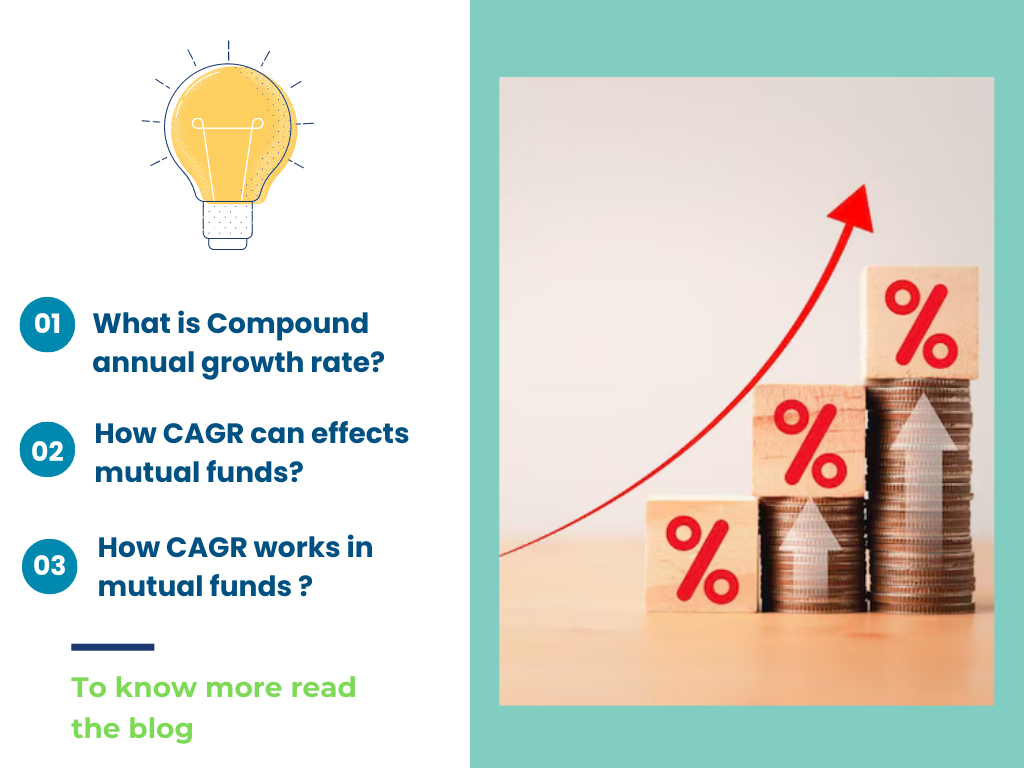What is Compound annual growth rate? How CAGR can effects mutual funds? How CAGR works in mutual funds?
Compound Annual Growth Rate (CAGR) can be calculated with respect to Indian Rupee (INR) just like any other currency. The calculation of CAGR in INR will depend on the investment or asset being measured, as well as the time period under consideration.
For example, if you had invested Rs. 1,00,000 in a mutual fund on January 1, 2018, and the value of your investment had grown to Rs. 1,50,000 by December 31, 2021, the CAGR over the 4-year period would be calculated as follows:
CAGR = (Ending Value / Beginning Value)^(1 / Number of Years) - 1
CAGR = (Rs. 1,50,000 / Rs. 1,00,000)^(1/4) - 1
CAGR = 14.28%
Thus, the CAGR in INR for this investment over the 4-year period is 14.28%. This means that on average, the investment grew at a rate of 14.28% per year, compounded annually over the four years.
It's important to note that the actual returns of a mutual fund or any other investment in INR may be impacted by factors such as market volatility, inflation, fees and expenses, and currency fluctuations, among others.
CAGR can effects mutual funds as following ways :
CAGR (Compound Annual Growth Rate) is a measure of the average annual growth rate of an investment over a specific period of time, taking into account the compounding of returns. CAGR is commonly used to assess the performance of mutual funds. Here's how CAGR can affect mutual funds:
Performance Evaluation: CAGR provides a standardized way to evaluate the historical performance of mutual funds. It allows investors to compare the returns of different funds over the same time period. Mutual funds with higher CAGR values generally indicate better long-term performance.
Investment Planning: CAGR helps investors estimate the potential growth of their investments in mutual funds over the long term. By considering the CAGR of a fund, investors can make informed decisions about the expected returns and the suitability of a particular mutual fund for their investment goals.
Volatility and Risk Assessment: While CAGR provides an average growth rate, it doesn't capture the volatility or fluctuations in the fund's returns. Investors should consider additional measures, such as standard deviation or beta, to assess the risk associated with a mutual fund. A high CAGR may indicate good performance, but it's essential to evaluate the fund's risk profile as well.
Benchmarking: Comparing a mutual fund's CAGR with a relevant benchmark index can help determine whether the fund has outperformed or underperformed the market. It allows investors to gauge the fund manager's skill in generating returns above the market average.
Long-term Investment Planning: CAGR is particularly useful for long-term investment planning. It helps investors project the potential growth of their investments over an extended period, considering the compounding effect. This can aid in setting realistic financial goals and selecting appropriate mutual funds for achieving those goals.
It's important to note that CAGR is based on historical performance and may not necessarily reflect future returns. Past performance is not a guarantee of future results, and other factors such as market conditions, fund management, and economic factors can also impact mutual fund performance. Therefore, it's advisable to consider CAGR along with other relevant factors when evaluating mutual funds.


